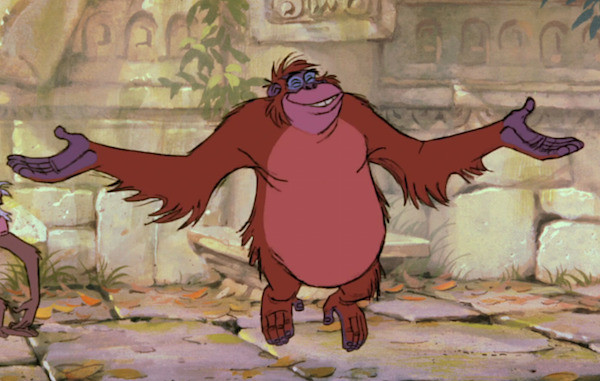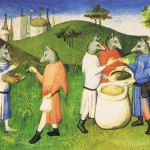The Salvation of Dog-men and Orangutans
by Matthew Allen Newland
Filed under Christianity and Science
I recently read, with fascination, Michael F. Flynn's article at Strange Notions, entitled "St. Christopher, ET, and the Middle Ages". There, Flynn discusses (among other things) the possibility of extraterrestrial life, and the question of what it means to be "human" (is it a matter of evolutionary descent or something else?). He makes a very interesting case by referring to written Medieval encounters with a race of dog-headed people, which include even the strange story of St. Christopher, who some believed had been one of them (changing to human form, I believe, only after being baptized ... making his conversion a particularly life-changing experience).
What I liked best about the article was the fact that Flynn didn't try to explain what these dog-men might have been. Instead, Flynn gets to the more philosophical question of our identities as human beings, and how we can consider beings so different from us (whether dog men or extra-terrestrial intelligences) to be like likes, and capable of receiving and benefiting from GOD's message and presence in the world.
Of course, this is not really a new question. C.S. Lewis famously considered it in his Space trilogy (Out of the Silent Planet and its sequels), and Europeans had to grapple with the discovery of entirely unknown (and in their minds inexplicable) people in the Americas (the subsequent enslavement of the American Indians is a sadly forgotten chapter in U.S. history). In light of this, it is when Flynn discusses the nonetheless human nature of these strange dog-headed people that things get particularly interesting. I quote him:
"When a medieval said that the Dog-Heads were 'degenerated descendants of Adam,' they had in mind that they were rational beings, not that they belonged to a biological species, although "common descent" is implicit in it. Which brings us back to 'St. Christopher the Dog-Head.' Why was it that no ones seemed to be any more outraged that a Dog-Head could be baptized ... ?"
These questions may be speculative, but they are relevant, even in our time. And not because, even if there are no dog-headed people, there may be aliens or other forms of intelligent life elsewhere in the cosmos. I think that we can already ask such questions of creatures perhaps less exotic, though certainly interesting (and familiar) to most of us: The great apes, such as the orangutans of Indonesia.
“I Wanna Be Like You”
Anyone who has seen the Disney animated classic The Jungle Book (1967) remembers King Louie, the orangutan who desires to be human. In his memorable song, he sings to Mowgli, the feral child he has kidnapped:
"I wanna be a man, mancub
And stroll right into town
And be just like the other men
I'm tired of monkeyin' around!"
King Louie hopes that Mowgli can teach him the secret of making fire, he says to him, "So I can be like you". Interestingly, since Mowgli was raised by wolves (literally), neither does he know the secret of making fire. Yet does this make Mowgli less than human in King Louie's eyes? ... Let's move on.
Orangutans probably didn't descend from Adam the way these dog-headed people were believed to have been. But the question I am interested in right now is this: What makes a rational being “rational”? What counts as a uniquely "human" thought or ability? What makes a dog-headed convert to Christianity human, yet is somehow denied King Louie in the Disney film?
With King Louie in mind, let's look at orangutans.
Physiologically, orangutans share a long list of similarities with Homo sapiens, as recounted by anthropologist Lyn Miles, which include, she states,
"a similar gestation period, brain hemispheric asymmetry, characteristics of dentition, sexual physiology, copulatory behavior, hormonal levels, hair pattern, mammary gland placement, and insightful style of cognition".1
Orangutans have also been observed to stand and walk fully upright while occupying tree branches, using their free hands to pick fruit from overhanging limbs otherwise beyond their reach.2 This has lead anthropologists such as Susannah K. S. Thorpe to theorize that a similar bipedal stance was common to all tree-dwelling apes up to five million years ago, until diminishing forest lands in Africa imposed changes onto the apes that would serve as the ancestors of present-day gorillas, chimpanzees, and Homo sapiens.3
The conclusion of such a view is that while the ancestors of Homo sapiens eventually regained their ability to stand fully erect, as other African great apes advanced no further than knuckle-walking, the Asian ancestors of the orangutans preserved this ancient ability.4 The orangutan thus serves as an important link to Homo sapiens' most distant prehistoric past, for it retains both a lifestyle and physiological features once possessed by both their common ancestors, abandoned by every other species of great ape. This sentiment is reiterated by Miles, who notes,
“Both the fossil data and comparisons of DNA and other biochemical measures suggest that the orangutan is the most conservative, or primitive, of the great apes. They are most like the ancestral hominoid (ape-like primate) living about twelve million years ago that later gave rise to apes and humans. Orangutans have retained more of the characteristics of this hominoid than have the African apes. As a result, orangutans have been labeled a 'living fossil', and thus are a kind of time traveler."5
In addition to such physiological traits as bipedalism, the observation of orangutans in both their natural habitat and in captivity has revealed startlingly Homo sapiens-like behavior and abilities. While orangutans in the jungles of Sumatra and Borneo have been observed to build shelters and teach one another to use simple tools,6 orangutans in captivity have been taught to tie knots,7 make stone tools (specifically blades out of flint), and put them to practical use.8 The facts of physiological and behavioral similarity, common ancestry, and capacities for culture and tool use all point to the conclusion that the orangutan should be viewed as an ideal candidate for consideration in the quest for humanity beyond the species Homo sapiens.
Of course, the power of speech is one thing which orangutans obviously lack. While their vocal chords are not suitable for spoken language,9 the red apes of Sumatra and Borneo have nevertheless demonstrated linguistic abilities through experiments in which captive individuals were taught to use American Sign Language. Lyn Miles was the first anthropologist to conduct such an experiment with an orangutan. Miles, for over a period of nine years, instructed and observed a young orangutan named Chantek, whom she raised from infancy as she would have a human child.10 At the age of ten months, Chantek began to demonstrate his understanding of the signs being taught to him by signing to his caregivers on his own.11 As time passed, Chantek displayed an ability to use 150 different words.12 He also showed himself to be capable of understanding the corresponding terms for the signs in spoken English, as his teachers often vocalized the words they signed when they addressed him. Chantek demonstrated this ability to recognize spoken words by performing the signs corresponding to words he recognized while listening to the radio.13
Chantek also demonstrated the ability to sign for things which were not in front of him, like ice cream (showing he retained the idea of things even after they were no longer in view and could signal his desire for them), and the ability to lie (he would take little objects he wanted to keep, like pencil erasers, hide them, and then claim not to know where they were).14
Of course, Chantek is just one orangutan, but as mentioned already, many orangutans have been observed to skillfully carry out intelligent actions, such as, again, making stone tools and shelters. But one other orangutan deserves a mention, because his story is so interesting (and as a native Nebraskan, I am happy to share it).
In the 1960s the Omaha zoo gained the addition of a baby orangutan named Fu Manchu. In due time, Fu Manchu became notorious for his habit of escaping from his cage. The first time it happened, head zookeeper Harry Stones discovered Fu Manchu and several other orangutans lounging about in trees outside their habitat, the door connecting his habitat/exhibit to the furnace room wide open. At first, the zookeepers assumed that it had been left unlocked by accident, until it happened again and again. Jobs were on the line ("I was about to fire someone," Stones said), as it was assumed that the staff were being negligent about securing the orangutans after feeding them.15
Finally, though, Stones was able to catch Fu Manchu in the act. Hiding one day and watching the orangutan exhibit after hours, Stones watched as Fu Manchu jumped up and climbed the air vents. He reached the furnace room door, forced a gap open, and then slipped the piece of wire into the gap to unhook the latch on the other side. Until then, no one had noticed the wire Fu Manchu used because Fu Manchu had bent it to fit between his lip and gums, where he concealed it in between his escapes.16
“Tell them that is human nature”
Now, what does all this mean? This is where I have to stop and leave you to speculate. After all, I have no answers, only questions. If the rational human soul is thought to be in evidence by the intelligent behaviour of its possessor, where do we draw the line? What about human beings who lack the abilities of the orangutans I have just discussed, due to developmental disabilities? How can we deny the humanity of one while defending the humanity of the other?
While the medievals had no concept of species as we do today in contemporary biology, the fact that the dog-people were descendants of Adam (and thus of the same "kind" as us, regardless of their appearance) means they had a familial understanding of human nature (that being human includes being descended from another human being).
Is it reasonable to expand the definition of "humanity" to include other apes? Do we do this already when we regard now extinct members of the genus Homo as humans, like Homo erectus or Homo neanderthalensis (better known as the Neanderthal)? Of course speculating on their human nature matters very little to them, at this point, for all this is left of them are their bones and tools.
This is not to say that the question is not important, though. In fact, it is critical. For as their environment is destroyed and as poachers diminish their numbers, the continued survival of our surrogate "dog men", orangutans and the other great apes, becomes ever more unlikely. If they are humans after all, would it make a difference in how we treated them? (Knowing humans--that is, knowing Homo sapiens--perhaps not).
Finally, one last thing to consider. The question of extraterrestrial life is a fascinating one, and our response to its possibility may also influence our decision here, regarding the nature of the apes with whom we share this planet. If we can imagine aliens being intelligent and receptive to God's Word and presence (like the beings in C.S. Lewis' Out of the Silent Planet), then we would imagine that their souls come not from Adam and Eve, but through a separate Creation by God. And surely we could, if we use our imaginations now, imagine God bringing new people to life from the stones on the ground outside (or make dragons and have their fallen teeth rise up as human beings).
If aliens can have souls, is it any less of a stretch to imagine that kindred species could have souls as well? Or perhaps that Adam and Eve were in fact not Homo sapiens at all, but an earlier species from which we, and all other apes, are common descendants? (Recall again Miles' remark that orangutans have retained more of the characteristics of more ancient ancestral apes than have gorillas, chimpanzees, or ourselves.)
What began as idle speculation becomes much more serious when we consider the plight of the great apes of our world, gorillas, chimpanzees, and orangutans alike, and if we wish to protect them from extinction.
Perhaps King Louie was already one of us?
Related Posts
Notes:
- Ibid., 45. ↩
- Bower, Bruce. “Red Ape Stroll.” Science News. 172 (Aug. 4, 2007). 72-73 ↩
- Ibid., 72-73. ↩
- Ibid., 72-73. ↩
- Miles, H. Lyn White. "Language and the Orangutan." The Great Ape Project: Equality Beyond Humanity, eds. Paola Cavalieri and Peter Singer. (New York: St. Martin’s Press, 1993). 45. ↩
- Ibid., 45-46. ↩
- Herzfeld, Chris and Dominique Lestel. “Knot Tying in Great Apes: Etho-Ethnology of an Unusual Tool Behavior”. Social Science Information, Vol. 44, No. 4 (2005): 621-653. ↩
- Miles, pg. 45. Miles notes a particular orangutan who broke off a sharp piece of flint, which he then used to cut the string tying down the lid of a box containing food. ↩
- Miles. 46. ↩
- Ibid., 46-47. ↩
- Ibid., 46. ↩
- Ibid., 47. ↩
- Ibid., 48. ↩
- Ibid., 48. ↩
- Lindon, Eugene. “Can Animals Think?.” Time. Sunday, Aug. 29, 1999. ↩
- Ibid. ↩
Note: Our goal is to cultivate serious and respectful dialogue. While it's OK to disagree—even encouraged!—any snarky, offensive, or off-topic comments will be deleted. Before commenting please read the Commenting Rules and Tips. If you're having trouble commenting, read the Commenting Instructions.













